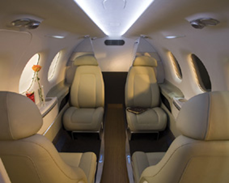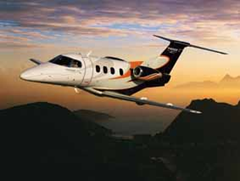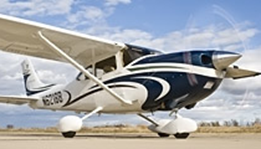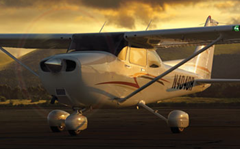Vincent of Plastic Pilot has just posted a story sent to him by a pilot named Jeff who recently experienced a major instrument (Garmin and GPS) failure shortly after take-off that left him GLAD that he had learned how to fly using the old mechanical instruments. The story only further adds to the debate of modern technology (glass cockpits, GPS etc.) verses traditional technology (mechanical gauges etc.) and is a reminder of past stories or advice reported on other blogs.
Embraer’s Phenom 100
Thomas A. Horne recently paid a visit to an Embraer aircraft factory in Brazil and wrote a detailed article (Turbine Pilot: Thrill from Brazil) for AOPA Online about their latest entrant into the light aircraft / business jet market: the Phenom 100. With an average equipped price of US$3.6 million, the plane’s designers intend the Phenom 100 to compete with Cessna’s Mustang and their stated goal was to give the aircraft a so-called “balanced” performance where no element of the aircraft performs better or worse than that of a competing aircraft.
Thomas was able to take the aircraft up for two test flights and write a very detailed review of its performance where he concludes that they have largely achieved their intended goal:
The Phenom 100 delivers on its promises—as long as temperatures are on the cool side. It’s a sturdy (airframe life limit is 35,000 hours), capable, comfortable airplane that handles well, is a great instrument platform, rides turbulence with aplomb, is long on comfort, and is backed up by 600-hour/12-month service intervals and datalinked fault diagnostics that communicate to service centers in near real time.
For anyone thinking of purchasing or flying a Phenom 100, the article is well worth a read and shows just how far Embraer has come in becoming a force to be reckoned with in business jet market.
Flying in Class Bravo Airspace video
Jason Schappert has created and posted a number of short but very useful video podcasts on his site, MzeroA.com (His previous video podcasts include: Understanding and Reading TAF’s, Uncontrolled Airport Operations, How to Read METARS, Runway Signs and Markings, Proper engine run up procedure, Preflighting and Cross country deviations on the fly). His latest video podcast is entitled Flying in Class Bravo Airspace. For European pilots not familiar with the term, “Class Bravo” (or Class B) is the American term for the airspace from the surface to 10,000 feet that is normally found around the busiest and most congested airports. In order to fly in such airspace, a pilot must first contact ATC and receive a clearance to enter the airspace.
Jason proceeds to walk a pilot through the necessary procedures to enter “Class Bravo” airspace and the great part about his video podcast is that he includes actual transmissions between himself and ATC between commentary about entering and flying in Class Bravo Airspace. This video podcast, along with the previous ones he has created are well worth checking out.
Q-route discussion
For anyone flying across the pond, AskaCFI.com has posted two queries regarding Q-routes: Can you use a Q-route below FL180? (written by Max Trescott) and a follow-up question entitled What the heck is a Q-route? (written by Paul Tocknell) that was asked by a reader who had read the first post. To address the second question, Paul backtracks and gives a useful backgrounder about the three types of airways found in the USA which are 1) VOR Federal airways, 2) Colored Federal Airways and 3) RNAV airways. As for RNAV airways, these types of airways have two types of routes: 1) Q-routes (high – 18,000 feet MSL and FL 450 inclusive) which are depicted on Enroute High Altitude Charts and 2) T-routes (low – 1,200 feet up to 17,999 feet MSL) which are depicted on Enroute Low Altitude Charts.
Visual entry into a holding pattern
Patrick Flannigan has posted a short entry on AirChatter.com entitled Holding Pattern Entries Made Easy! As Patrick explains, there are three ways to enter a holding pattern (parallel, direct or tear drop) and entry really depends upon a plane’s intercept angle with the holding pattern. However, rather than do any kind of mental math to compute an entry, Patrick says that he does it all visually using three simple rules which he outlines. In his words, choosing one of these rules to follow sure beats doing a bunch of mental math while also trying to fly the airplane.
The post is worth a quick read and Patrick also invites comments on his method of entry as well.
The Cessna 182 vs. the Cessna 172
Brian of Brian’s Flying Blog recently posted a very detailed response to an email he received regarding whether or not the Cessna 182 (Skylane) was harder to fly that the Cessna 172 (Skyhawk). His answer: Any private pilot should be able to fly a Cessna 182 with some instructions from a instructor who regularly flies one.
In general, Brian comments that the Cessna 182 is a great plane that can carry 4 people and baggage well but depending on the weight of the passengers and baggage, it may not be able to carry a full fuel tank. Another downside he describes is the fact that the plane is a bit nose heavy which is noticeable during flaring. However, the Cessna 182 is more roomier than the Cessna 172 and Brian says he was even able to fit someone in the back who was 6′ 8″.
Brian then provides a fairly detailed evaluation of the Cessna 182 for takeoffs, speed and slowing down, landing and flares, stalls, stability and carb heat usage and hence, the post is well worth a read by any pilot who plans to rent or fly one on a regular basis.



